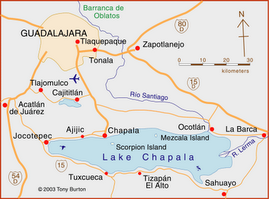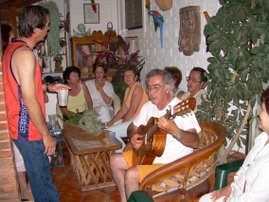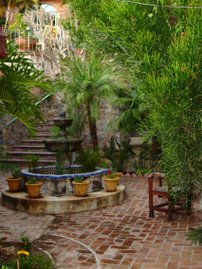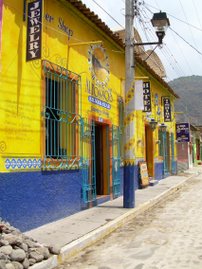
Jacaranda
The jacaranda blooms, my spirit fed.
Frail branches bend to touch my heart
Lavender flowers falling soft upon my head.
As our misfortunes often lead to dread
And taste upon my tongue is sometimes tart
The jacaranda blooms, my spirit fed.
Its beauty is but brief, and I am led
To drink its nectar quickly, lest it depart
Lavender flowers falling soft upon my head.
Since to the heat of Mexico I’ve fled,
I step with awe into each day’s new start
The jacaranda blooms, my spirit fed.
And here among the plants, my life is wed
With unexpected joy, and nature’s art
Lavender flowers falling soft upon my head.
For at the end of every day it’s said
That precious moments linger as we part
The jacaranda blooms, my spirit fed
Lavender flowers falling soft upon my head.
Well, Jacaranda season has arrived. Pictured above is the beautiful Jacaranda tree, so ubiquitous in this area of Mexico. This tree, prolific throughout subtropical seasons is noted for its beautiful blossoms and much-needed shade. One Amazonian myth suggests that early people would meet to make important decisions under the Jacaranda tree, and that it has been called the tree of knowledge or justice.
I have my own theories which I have expressed the the poem above. The form of this poem is a villanelle. This rhyming, metered poetic form has two rhyming, repeated refrains and follows a strict rhyme scheme. The most famous villanelle with which you may be familiar is "Do Not Go Gentle into that Good Night" by Dylan Thomas. I had been working on this for awhile, and am glad to have finished it while the Jacaranda are blooming.
Of course, around here, Jacaranda season is infamous for bringing on seasonal allergies, as it has for me. But the beauty of Jacarandas gracing the streets and gardens makes it worth it!
I have some additional photos to illustrate a few of the things I was discussing in the last post. First, here is a photo of my three Mexican English language students, from left Belin, Bertha, and Francisco.

As I mentioned in the last post, we were preparing to host the Maine/New Hampshire group at our house last week. We had about 20 New Englanders attend where we enjoyed drinks and appetizers on the back terrace. Here are a couple of photos of our "Down East" and "Live Free or Die" friends (the second from the left in the right photo is Brian. He is from Massachusetts, but he's a good guy!):

And finally, I mentioned that we enjoy attending, and sometimes leading, our Great Books discussion group. I asked them to pose for a group photo last week, sans Pixie and me. The result is below. From left: Kenya and George, Paul, Rick, Suzanne, Luis, Fred, and Aida. This is a wonderful collection of minds which leads to thoughtful observations and spirited discussions. One person, Jill Ann, is missing from the photo because she unfortunately broke her hip while on a vacation in Cairo. Fortunately she is back in Mexico and healing now.
You may remember I have been writing a bit about a new book on Mexican geography, Geo-Mexico. Rick, above, is the coauthor of that book. He is speaking this week at the Iowa City Foreign Relations Council and sent me an interesting quote from his speech which addresses Mexico's uncomfortable relationship with catholicism, and I am using it here with his permission:
Oh, but isn’t Mexico a Catholic country? Well, not exactly. Since gaining independence 200 hundred years ago, the Government has suppressed the Church. The Government confiscated all church property in 1857. The current 1917 Constitution, written after the Mexican Revolution, forbids churches from participating in primary and secondary education, denies legal standing to religious marriages, and prohibits the clergy from criticizing the Government or wearing religious attire in public. These restrictions were enforced so strenuously, that they provoked the Cristero Rebellion in 1926. Over 50,000 devout Catholics in Western Mexico took up arms against the Government. This three war cost 90,000 lives and reduced the number of priests in the country from 4,500 to only 334. Many Priests and staunch Catholics were killed, others immigrated to the U.S. Things have gradually improved, restrictions have been rescinded, and the Government finally established diplomatic relations with the Vatican in 1992.
Not what we might expect. In fact, Mexico has very strong divisions between church and state, which is why there are no catholic schools in Mexico and why the Church is not allowed to own any property other than the land a church is built on.
So, life goes on here. Things are relatively quiet now. The days are hot and the snowbirds have mostly left. Many people who live here take vacations north during April and May because of the heat. Many, like us, take leave during the summer months. So it is quiet and the traffic is not so congested now. I like this time of year.
I'd like to include one more reading in this post. My Dutch-American friend John De Waal has been working on a cause which many are skeptical about: getting Medicare benefits to cover treatment Americans receive in Mexico. The logic is simple. Medical care is good, and much less expensive here. Medicare could save money if people sought care here. It always seemed unlikely to me for political reasons. But John recently sent me an article form the Miami Herald which talks about cooperation between the Mexican and US governments to plan for many more retirees to move here from the US, including the Medicare issue. Likely? I don't know, but here's the article:
THE OPPENHEIMER REPORT
Mexico's big hope: get 5 million U.S. retirees
BY ANDRES OPPENHEIMER
MEXICO CITY -- Mexico is silently working on proposals aimed at drawing millions of U.S. retirees to this country, which could eventually lead to the most ambitious U.S.-Mexican project since the 1994 North American Free Trade Agreement.
President Felipe Calderón is likely to propose the first steps toward expanding U.S. retirement benefits and medical tourism to Mexico when he goes to Washington on an official visit May 19, according to well-placed officials here. If not then, he will raise the issue later this year, they say.
``It's one of the pillars of our plans to trigger economic and social well-being in both countries,'' Mexico's ambassador to the United States Arturo Sarukhan told me. ``We will be seeking to increasingly discuss this issue in coming months and years.''
Calderón brought it up during a U.S.-Canada-Mexico summit in Guadalajara in August last year, but President Barack Obama asked him to shelve the idea until he was able to pass healthcare reform, another official told me.
Now that Congress has passed healthcare reform, Calderón is preparing to charge ahead.
A GROWING MARKET
There are already an estimated 1 million Americans living in Mexico. And according to Mexican government estimates based on U.S. Census figures, that number is likely to soar to 5 million by 2025 as the U.S. population grows older and more Americans look for sunny, cheaper places to retire.
The U.S. Census projects that the number of U.S. retirees will soar from 40 million now to nearly 90 million by 2050. Already, 5 million American retirees live abroad, of whom 2.2 million are in the Western Hemisphere -- mostly in Mexico, the Dominican Republic and Brazil. Another 1.5 million live in Europe and 850,000 in Asia.
The key to luring more U.S. medical tourists and retirees to Mexico and other Latin American countries will be getting hospitals in the region to be certified by the U.S. Joint International Commission, which establishes that they meet U.S. hospitals' standards. There are already eight Mexican hospitals certified by the JIC and several others awaiting certification.
According to Mexican government estimates, healthcare costs in Mexico are about 70 percent lower than in the United States. And from my own experience, those estimates are right: As I reported at the time, when I was hospitalized in Mexico two years ago for an emergency operation, my hospital bill was indeed about 70 percent lower than what it would have been in Miami.
So what will Calderón specifically propose to Obama? Most likely, the Mexican president will suggest starting with a low-profile agreement that would allow the U.S. Health Care Financing Administration to pay for Medicare benefits to U.S. retirees in Mexico. Under current rules, Medicare only covers healthcare services in the United States.
IT JUST MAKES SENSE
My opinion: Mexico and much of Latin America are bound to become growing U.S. retirement and medical tourism destinations, much like Spain has become a permanent living place for Germans, Britons and Northern Europeans.
You won't read much about it now because neither Calderón nor Obama will emphasize it publicly while the drug-related violence in northern Mexico is making big headlines, and while the political wounds from the recent U.S. healthcare debate are still open in Washington, D.C.
But I'm increasingly convinced that, as the violence in Mexico subsides and the healthcare debate becomes a distant memory in Washington, medical benefits' deals will become a top U.S.-Latin American priority. Just as free-trade agreements were the big thing of the 1990s, healthcare agreements will be the big deal of the coming decade.
I wouldn't be surprised if Calderón and Obama take the first baby steps toward a U.S.-Mexico healthcare agreement by finding a way to pay for Medicare benefits for U.S. expatriates in Mexico, or getting U.S. states to allow similar payments. Then, most likely after the 2012 presidential election in both countries, the two would start negotiating a more ambitious deal.
Demography, geography and economics are pointing in that direction. With the U.S. population getting older, a record U.S. budget deficit, rising U.S. healthcare costs, and Mexico and other Latin American countries badly needing more tourism and investments, this should be a win-win for everybody.








































































1 comment:
j3d80t3y81 i9h83t7d99 d2m03g0n33 k7z18s6r06 h0i35r2k65 z5e59l5n61
Post a Comment